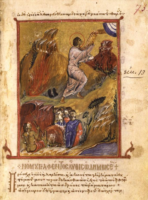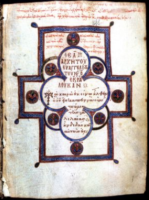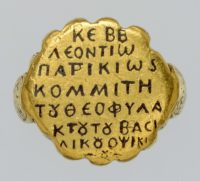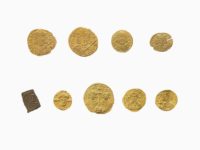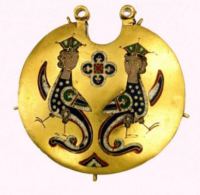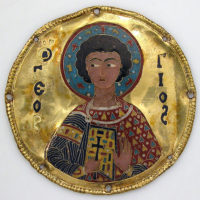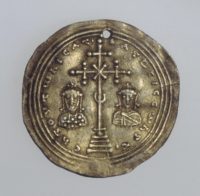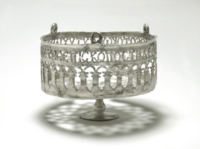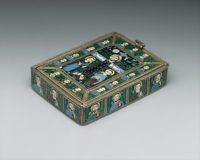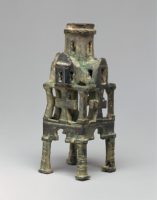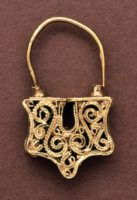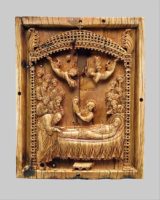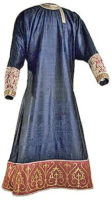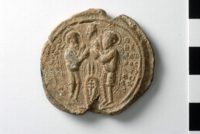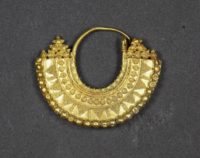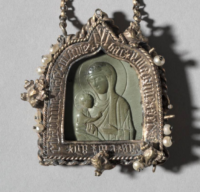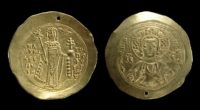Psalter and New Testament, Period: Middle Byzantine, circa. 1084 A.D. The museum is open to the public Tuesday through Sunday, 11:30 a.m.–5:30 p.m., except for federal holidays.
Gospel Lectionary with Marginal Illuminations, Period: Middle Byzantine, 2nd half of 11th Century AD. The museum is open to the public Tuesday through Sunday, 11:30 a.m.–5:30 p.m., except for federal holidays.
Ring of Leontios, Period: Middle Byzantine, circa: 1000, Materials: Gold, niello, Inscribed: “Lord help Leontius, Patrician and Count of imperial Obsikion guarded by God”. The ring came from Leontios of the district of Opsikion, in exactly what is currently northwestern Turkey. Patrikios as well as komes were Roman titles that moved in definition throughout the Byzantine period; it promises that Leontios was the guv of the district or an upper-level general. On view at The Met Fifth Avenue in Gallery 303 . The Metropolitan Museum of Art (New York) is one of the world’s largest and finest art museums. Its collection includes more than two million works of art spanning five thousand years of world culture, from prehistory to the present and from every part of the globe. Public Hours: 10:30 a.m.–5:30 p.m. Open seven days a week.
Coin, Ruler: Tiberius III, Byzantine Emperor; circa: 705-711; Minted in: Ravenna. Weight: 4.309 grammes. British Museum is closed 24, 25 and 26 December and 1 January, but is open every other day of the year. Fast facts about the British Museum: Founded: 1753, Collection size: 8 million objects, Oldest object in the collection: Stone chopping tool (nearly 2 million years old).
Dish of brown, fine-grained clay covered with a white slip. Period: Middle Byzantine; circa: Late 12th-early 13th c. The decoration is in champlevé, while the individual details are incised. A large standing bird is pictured between two bird-shaped animals resembling griffons but without wings. Dimensions: H. 0.07, Diam. of rim 0.235, Diam. of base 0.08 m. On the ground tufted plants. Yellow, very good quality glaze covers the inner surface and the edge of the rim on the outside. The Benaki Museum of Greek Culture is housed in one of the most beautiful neoclassical-style buildings in Athens, near the National Garden and the Hellenic Parliament.
Pair of Kolti with Sirens, Period: Middle Byzantine Period, ca. 843-1204 AD. Late 11th-12th Century. The museum is open to the public Tuesday through Sunday, 11:30 a.m.–5:30 p.m., except for federal holidays.
Medallion with Saint George from an Icon Frame, Period: Middle Byzantine, circa: 1100, Made in Constantinople, Materials: Gold, silver, and enamel worked in cloisonné. On view at The Met Fifth Avenue in Gallery 303. The Metropolitan Museum of Art (New York) is one of the world’s largest and finest art museums. Its collection includes more than two million works of art spanning five thousand years of world culture, from prehistory to the present and from every part of the globe. Public Hours: 10:30 a.m.–5:30 p.m. Open seven days a week.
Miliarensis of Basil II and Constantine VIII, Period: Middle Byzantine, circa: Between 989 and 1025, Material: silver, Technique: chased and gilded. The collection of the State Hermitage includes over 3 million works of art and world culture artefacts. It contains paintings, graphic works, sculptures, works of applied art, archaeological artefacts and numismatic objects. The Hermitage is considered to have been founded in 1764, when Empress Catherine the Great acquired an impressive collection of works from the Berlin merchant Johann Ernst Gotzkowsky. The museum celebrates the anniversary of its founding each year on 7 December, St. Catherine’s Day. Opening Hours: Tuesday, Thursday, Saturday, Sunday: 10.30-18.00 Wednesday, Friday: 10.30-21.00 Closed: Monday.
Openwork Lamp with Openwork Inscription, Period: Middle Byzantine, circa Mid. 6th Century A.D. The museum is open to the public Tuesday through Sunday, 11:30 a.m.–5:30 p.m., except for federal holidays.
The Fieschi Morgan Staurotheke, Period: Middle Byzantine, circa: early 9th century, Made in Constantinople, Materials: Gilded silver, gold, enamel worked in cloisonné, and niello. On view at The Met Fifth Avenue in Gallery 303. The Metropolitan Museum of Art (New York) is one of the world’s largest and finest art museums. Its collection includes more than two million works of art spanning five thousand years of world culture, from prehistory to the present and from every part of the globe. Public Hours: 10:30 a.m.–5:30 p.m. Open seven days a week.
Base for a Cross, Period: Middle Byzantine circa: 11th century. Made in Constantinople. Materials: Copper alloy, cast, filed, reamed, and scraped. Dimensions: Overall: 5 x 1 15/16 x 2 1/16 in. (12.7 x 4.9 x 5.2 cm); Top (Diameter-Top exterior): 1 1/16in. (2.7cm). On view at The Met Fifth Avenue in Gallery 303. The Metropolitan Museum of Art (New York) is one of the world’s largest and finest art museums. Its collection includes more than two million works of art spanning five thousand years of world culture, from prehistory to the present and from every part of the globe. Public Hours: 10:30 a.m.–5:30 p.m. Open seven days a week.
Gold Earring, Period: Middle Byzantine. circa: 12thc. Length: 1.24 inches. British Museum is closed 24, 25 and 26 December and 1 January, but is open every other day of the year. Fast facts about the British Museum: Founded: 1753, Collection size: 8 million objects, Oldest object in the collection: Stone chopping tool (nearly 2 million years old).
Icon with the Koimesis, Period: Middle Byzantine, circa: late 900s. Made in probably Constantinople. Material: Ivory. On view at The Met Fifth Avenue in Gallery 303. The Metropolitan Museum of Art (New York) is one of the world’s largest and finest art museums. Its collection includes more than two million works of art spanning five thousand years of world culture, from prehistory to the present and from every part of the globe. Public Hours: 10:30 a.m.–5:30 p.m. Open seven days a week.
Tunic from Palermo; Blue and red velvet, gold embroidery, gold appliqués with cloisonné enamel and filligree, pearls; l. 141,5 cm, 343 cm wide at hem. Period: Middle Byzantine, circa: 2nd quarter of the 12th century. Kunsthistorisches Museum, Vienna. The Kunsthistorisches Museum was built in 1891 near the Imperial Palace to house the extensive collections of the imperial family. With its vast array of eminent works and the largest Bruegel collection in the world, it is considered one of the most eminent museums in the world. Opening hours June to August Daily, 10 a.m. – 6 p.m. Thu, 10 a.m. – 9 p.m. September to May Tue – Sun, 10 a.m. – 6 p.m. Thu, 10 a.m. – 9 p.m.
Seal, Theodore Kastamonites, Sebastos. The two Saints Theodore standing with their hands upraised towards the manus Dei above. Between them are their spears and a shield embossed with a patriarchal cross. This remarkable seal may well have belonged to Theodore Kastamonites, the maternal uncle of the emperor Isaac II Angelos (1185–1195, 1203–1204), who tended to the internal affairs of the empire during his nephew’s first reign. The museum is open to the public Tuesday through Sunday, 11:30 a.m.–5:30 p.m., except for federal holidays.
Gold Earring; semi-circular; with U-shaped loop to which is attached a similarly shaped thin plate of gold. Period: Middle Byzantine; 11thc.-12thc.; Found/Acquired: Syria. British Museum is closed 24, 25 and 26 December and 1 January, but is open every other day of the year.
Pendant Icon with the Virgin “Dexiokratousa” and Frame with Winged Bull of Saint Luke on the back, Pendant 1100s; Frame mid. Period: Middle Byzantine. Materials: Steatite, Gilt silver, Pearls. The Cleveland Art Museum Hours: Tuesdays, Thursdays, Saturdays, Sundays 10:00 a.m.–5:00 p.m. Wednesdays, Fridays 10:00 a.m.–9:00 p.m. Closed Mondays.
Gold coin; Ruler: Manuel I Comnenus, Byzantine emperor; circa: 1143-1180; Minted in: Constantinople. Weight: 4.484 grammes. British Museum is closed 24, 25 and 26 December and 1 January, but is open every other day of the year. Fast facts about the British Museum: Founded: 1753, Collection size: 8 million objects, Oldest object in the collection: Stone chopping tool (nearly 2 million years old).
Gold coin. Ruler: Tiberius III, Byzantine Emperor; Period: Middle Byzantine; circa: 705-711; Minted in: Ravenna, Italy. British Museum is closed 24, 25 and 26 December and 1 January, but is open every other day of the year. Fast facts about the British Museum: Founded: 1753, Collection size: 8 million objects, Oldest object in the collection: Stone chopping tool (nearly 2 million years old).
Textile Fragment, Materials: silk and cotton. Period: Middle Byzantine, circa: 8thc-9thc. Rectangular panel of woven silk sen onto a larger cotton cloth of irregular, roughly rectangular shape; two hunters on horseback, in a round frame with floral ornament. British Museum is closed 24, 25 and 26 December and 1 January, but is open every other day of the year.


